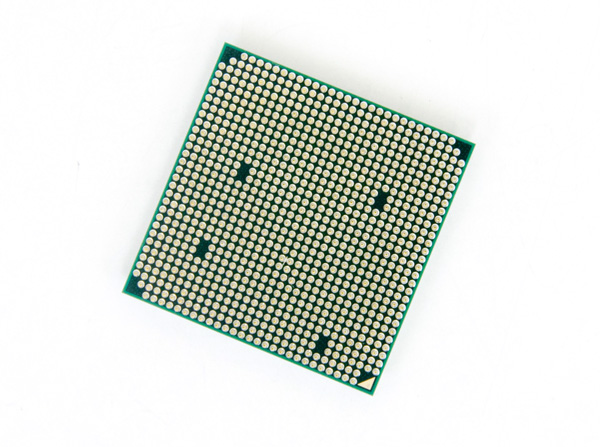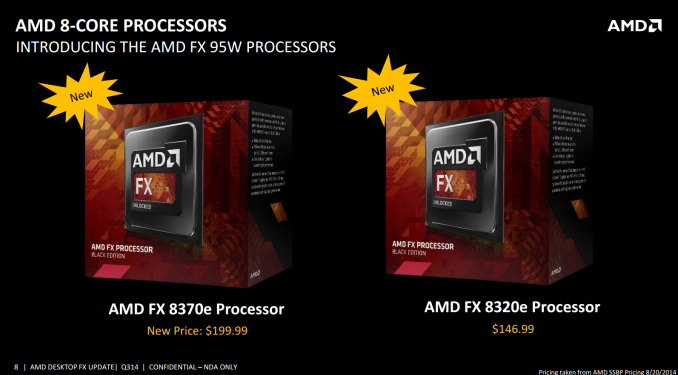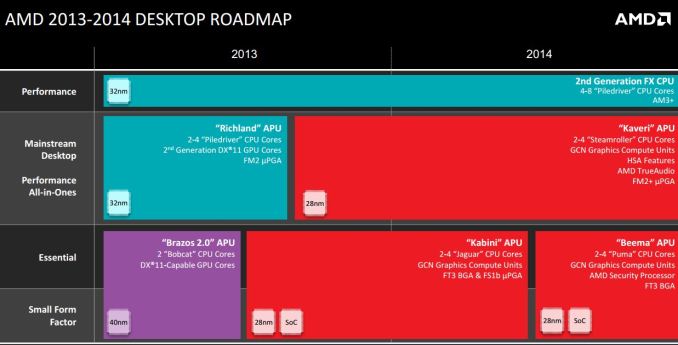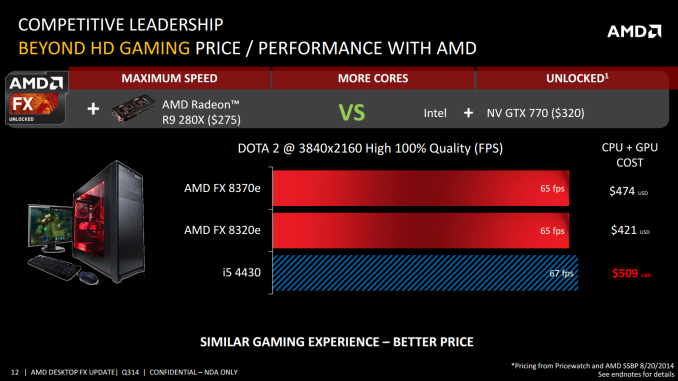AMD FX-8370E CPU Review: Vishera Down to 95W, Price Cuts for FX
by Ian Cutress on September 2, 2014 8:00 AM EST
I will be honest, after AMD did not update its FX processor line using the Steamroller architecture, I was not too hopeful for the brand to see anything new in 2014. But since the start of the year the 5 GHz turbo FX-9590 has been rereleased as a consumer part and today AMD is showing it can get four Piledriver modules down to 95W with a few frequency adjustments and cherry picking the dies. This is accompanied with price cuts for the eight-thread FX parts, which AMD is aiming squarely at similarly priced Intel i5 and i3 processors.
The Information
The new CPUs being released today come in three flavors. The FX-8370 is an upgraded version of the FX-8350, giving an extra bump in clock speeds over the FX-8350 in the same 125W envelope. The other two processors, the FX-8370E and FX-8320E, carry this new ‘E’ designation from AMD, representing their ‘energy efficient’ range. For these processors, this means a four-module die with 8 threads with turbo frequencies matching their non-E counterparts but base frequencies reduced slightly.
Part of this makes you wonder just how much energy is used per MHz to hit the high numbers. It only takes a relatively small drop in base frequency to net a large power gain. We saw similar things from AMD with their 65W configurable TDP Kaveri parts earlier this year.
The base frequency drop does come across as a larger number than a first glance might suggest. The FX-8370E is 700 MHz lower than the FX-8370, while the FX-8320E is only 300 MHz lower. While I can imagine that 700 MHz reduces the power consumption by 30W, the 300 MHz number might indicate a better binned CPU from AMD. One of the issues AMD will have however is the Turbo mode. In the past, only specific workloads seem to cause the low thread count/high frequencies to kick in, meaning that an abnormal workload will keep the frequency low.
Also, unlike on Intel’s side of the fence, the motherboard manufacturers have not embraced MultiCore Turbo on AMD with the same gusto. This is a feature that places all the cores of the CPU in its highest frequency state any time it is not idle in order to allow software to be completed faster at the expense of power consumption and some heat. While this does not affect our testing due to the way we test, it might affect the experience the user has on a day-to-day level by being down on the top turbo mode.
In terms of the processor architecture, one of the most obvious questions to ask is:
Why update the FX line with more Vishera based processors? Can’t we get an update?
AMD’s reasoning for these new processors, apart from the slowly increasing yields of the higher bin parts over the past year and tweaking the overall design, is because of the motherboards available on the market. Due to the construction of some of the early motherboards intended for AMD’s no-IGP line, these early motherboards could only support 95W or 125W maximum, let alone the 220W of the FX-9590/9370 behemoths. By releasing an 8-thread Vishera processor with a 95W TDP, this allows these users to upgrade without spending an extra $120-$200 on a new motherboard.
With our CPU sample from AMD, we were also sent one of the newest motherboards that shows this limitation. We ran a news item on the 990FX Killer when it was first announced, and it was interesting due to its use of M.2 on 990FX. One of the items I spotted at the time on the specifications sheet was its recommended limit of processors: 125W TDP maximum. At the time (December 2013) AMD’s Roy Taylor and I discussed this on Twitter. It seemed odd that new motherboards were coming out that would not support AMD’s fastest CPU, even though motherboard manufacturers and AMD’s partners wanted to push the FX-9590 as the top end product. To solve that conundrum, this line of E processors was launched.
At the moment, AMD’s future roadmaps do not include FX processors based on new architectures, and there is no publicly disclosed new chipset, as we discussed in our recent FX-9590 review.
However, during the pre-briefings for these processors with AMD, one series of lines from AMD’s Adam Kozak piqued my interest, regarding the future of the FX processor line. Particularly mentioned was the lack of further FX updates for the rest of 2014, however there were indications that 2015 might hold something. AMD’s James Prior answered an email of mine regarding the exact wording, and aside from confirming that AMD are committed to supporting the current AM3+ lineup, one line gives hope:
“The AMD of today is funding the AMD of tomorrow by working hard to ensure the ongoing success of products like FX.”
To say ‘today funds tomorrow’ is no big leap of the imagination, but ‘ongoing success’ could stress future updates for the FX line. Now that AMD has started this energy efficient nomenclature, it would make sense to sustain it and introduce it to more of its customers over time. The earliest indication is 2015 for anything slightly new, though it is currently difficult to predict exactly what would be coming. But if we take into context 'products like FX', it might imply that there are no future FX parts, or at least how we commonly recognize them.
But for now we have the energy efficient side of Vishera to test.
The CPU, The Chipset and The DRAM
While AMD is stating that the 32nm process for Vishera has been updated and tweaked over time to allow for better yields and more efficient products, they have not stated if the silicon is changed in any way. For all intents and purposes, 32nm is getting a bit long in the tooth in the land of processors – Intel’s 14nm designs and second generation tri-gate transistors/FinFETs are almost upon us and 32nm is some way behind.
| CPU Specification Comparison | |||||||||
| CPU | Manufacturing Process | Cores | GPU | Transistor Count (Schematic) | Die Size | ||||
|
Intel Haswell-E 8C |
22nm | 8 | N/A | 2.6B | 356mm2 | ||||
|
Intel Haswell GT2 4C |
22nm | 4 | GT2 | 1.4B | 177mm2 | ||||
|
Intel Haswell ULT GT3 2C |
22nm | 2 | GT3 | 1.3B | 181mm2 | ||||
|
Intel Ivy Bridge-E 6C |
22nm | 6 | N/A | 1.86B | 257mm2 | ||||
|
Intel Ivy Bridge 4C |
22nm | 4 | GT2 | 1.2B | 160mm2 | ||||
| Intel Sandy Bridge- E 6C | 32nm | 6 | N/A | 2.27B | 435mm2 | ||||
| Intel Sandy Bridge 4C | 32nm | 4 | GT2 | 995M | 216mm2 | ||||
|
Intel Lynnfield 4C |
45nm | 4 | N/A | 774M | 296mm2 | ||||
|
AMD Trinity 4C |
32nm | 4 | 7660D | 1.303B | 246mm2 | ||||
|
AMD Vishera 8C |
32nm | 8 | N/A | 1.2B | 315mm2 | ||||
AMD is keeping the new energy efficient CPUs in the AM3+ socket, which means the 990FX is still top of the chain. However, these new CPUs are aimed at the lower end motherboards or even the older chipsets that were not designed to cope with >95W TDPs. In AMD’s briefing, they specifically called out the 700 series that supported AM3 and DDR3, although this applies to 800 series and 900 series equally.
The 990FX+SB950 platform combination is still limited to PCIe 2.0 without using a PCIe 3.0 PLX chip, although the connection to the CPU in that orientation is still PCIe 2.0 - only the data between the GPUs is accelerated. Nevertheless this is still the latest platform from AMD to have SLI support, with the north bridge being able to use two PCIe 2.0 x16 slots. The south bridge gives out the IO, to which we get six SATA 6 Gbps ports that are RAID capable. No native USB 3.0 though, as this combination was introduced before USB 3.0 became a must-have feature. This is one of the common criticisms with AM3+ - it needs a chipset update. There are plenty of PCIe 2.0 x1 ports in order to use USB 3.0 controllers, however this adds cost and AMD motherboards are generally low cost to begin with. It also goes against the mantra AMD is using for the new energy efficient CPUs of keeping the motherboard.
Memory is still DDR3, with the new CPUs natively supporting DDR3-1866 MHz under JEDEC specifications. Nevertheless, in AMD’s pre-brief it was stated that DDR3-2133 overclocking should be possible on almost all samples, with DDR3-2400 being a potential. Normal rules apply with DDR3: if you are buying new, buy a single kit with all the modules you need rather than two kits of the same modules. A kit is by definition only designed to work with itself, and it may be too strict on its timings to work with another kit, even if that kit is the same type. That is why four module kits often have a lower specification than a dual module kit. If the kit cannot combine with another kit at the rated settings, it can be a hard problem to diagnose. However the DDR3 market is quite mature at this stage, with plenty of options available.
Competition and Market
There are many ways in which a manufacturer can order up the competition. We could have 8-thread CPUs against 8-thread CPUs, or we could put 95W CPUs against 95W CPUs. For these processors, due to the accompanied price reduction across most of the FX desktop line, AMD is deciding to compare setups based on price.
This slide AMD provided is rather amusing. It shows that an FX-8320E + R9 280X will perform similarly to an i5-4430 + GTX 770 while being $88 cheaper. This is despite the DOTA 2 benchmark being performed on a UHD monitor which would cost just as much. But then again, perhaps that extra $80 could be going on an SSD – AMD’s focus over the past few years has always been oriented towards the cost effectiveness.
In real terms, the FX-8370 sits between the FX-8350 and the FX-9370, and the FX-8370E/FX-8320E are both equally priced to their non-E counterparts. The tradeoff is that for the lower TDP option, you pay a bit more compared to if we just looked at the speed.
| AMD FX CPU Comparison | |||||||||
|
FX- 4350 |
FX- 6350 |
FX- 8320E |
FX- 8320 |
FX- 8350 |
FX- 8370E |
FX- 8370 |
FX- 9370 |
FX- 9590 |
|
| Release Date |
04- 2013 |
10-2012 |
09- 2014 |
10-2012 | 10- 2012 |
09- 2014 |
09- 2014 |
07- 2013 | 07- 2013 |
| Modules | 2 | 3 | 4 | ||||||
| L1 Cache (Code) | 128 KB | 192 KB | 256 KB | ||||||
| L1 Cache (Data) | 64 KB | 96 KB | 128 KB | ||||||
| L2 Cache | 4 MB | 6 MB | 8 MB | ||||||
| L3 Cache | 8 MB | ||||||||
| TDP | 125W | 95W | 125W | 95W | 125W | 220 W | |||
| Base Frequency | 4200 | 3900 | 3200 | 3500 | 4000 | 3300 | 4000 | 4400 | 4700 |
| Turbo Frequency | 4300 | 4200 | 4000 | 4000 | 4200 | 4300 | 4300 | 4700 | 5000 |
| Core Name | Vishera | ||||||||
| Microarchitecture | Piledriver | ||||||||
| Socket | AM3+ | ||||||||
| Memory Support | DDR3-1866 | ||||||||
| Price | $140 | $140 | $147 | $147 | $180 | $200 | $200 | $211 | $230 |
Unfortunately AMD’s pricing is not telling the whole story. For the FX-9370 and FX-9590, that pricing is for the CPU-only version, whereas the FX-8370 and below pricing includes a boxed cooler. AMD’s reasoning on this is that for users buying the 9000 series, even with the price cuts, many of them will either purchase the version with the all-in-one liquid cooler (+$80 or so), or use their own after-market cooling in order to deal with the 220W TDP.
If we do a direct comparison of the SEP of the new CPUs with prices at retail for Intel Haswell:
| SEP vs Retail | ||||
| CPU | TDP | Threads |
US Price (Newegg) |
|
| Core i5-4690K | 88W | 4 | $240 | |
| FX-9590 | 220W | 8 | $230 | |
| Core i5-4690 | 84W | 4 | $225 | |
| Core i5-4670K | 84W | 4 | $220 | |
| FX-9370 | 220W | 8 | $211 | |
| Core i5-4590S | 65W | 4 | $200 | |
| Core i5-4590 | 84W | 4 | $200 | |
| FX-8370 | 125W | 8 | $200 | |
| FX-8370E | 95W | 8 | $200 | |
| Core i5-4460 | 84W | 4 | $190 | |
| Core i5-4430 | 84W | 4 | $190 | |
| FX-8350 | 125W | 8 | $180 | |
| Core i3-4370 | 54W | 4 | $160 | |
| FX-8320 | 125W | 8 | $147 | |
| FX-8320E | 95W | 8 | $147 | |
| Core i3-4350 | 54W | 4 | $145 | |
At the high end, the FX-9590 has competition with the i5-4670K although with twice as many threads in tow. At the FX-8370 level, the pricing of both the Core i5-4590 and the S model would make for an interesting battle if we had these CPUs in to test. For the FX-8320E, we are split between two Core i3s, meaning that the i3 with two cores and HyperThreading is up against a full 8 threads from the FX-8320E. While this seems one sided, the i3’s power consumption is almost half that of the FX processor. AMD is also keen to point out that all of its CPUs are unlocked for overclocking, unlike the competition where it is limited.
This Review
At this point in time AMD is currently only sampling the FX-8370E to the press, with the other CPUs to follow later this month. Due to our sample arriving only yesterday, this aims to be a quick overview of performance against other processors we have already tested. Note we only have a few from the list above, but as the new processors arrive we can aim for a more targeted punch-counterpunch scenario with overclocked testing. Our testing today encompasses the usual array of CPU and gaming benchmarks at stock speeds and official supported memory frequencies.
Test Setup
| Processor | AMD FX-8370E | 4M/8T | 3.3 GHz / 4.3 GHz | |
| Motherboard | ASRock 990FX Extreme9 | |||
| Cooling |
Corsair H80i Cooler Master Nepton 140XL |
|||
| Power Supply |
OCZ 1250W Gold ZX Series Corsair AX1200i Platinum PSU |
1250W 1200W |
80 PLUS Gold 80 PLUS Platinum |
|
| Memory | G.Skill 2x4 GB | DDR3-1866 | 8-9-9 1.5V | |
| Memory Settings | XMP | |||
| Video Cards | MSI GTX 770 Lightning 2GB (1150/1202 Boost) | |||
| Video Drivers | NVIDIA Drivers 337.88 | |||
| Hard Drive | OCZ Vertex 3 | |||
| Optical Drive | LG GH22NS50 | |||
| Case | Open Test Bed | |||
| Operating System | Windows 7 64-bit SP1 | |||
| USB 2/3 Testing | OCZ Vertex 3 240GB with SATA->USB Adaptor | |||
Many thanks to...
We must thank the following companies for kindly providing hardware for our test bed:
Thank you to OCZ for providing us with PSUs and SSDs.
Thank you to G.Skill for providing us with memory.
Thank you to Corsair for providing us with an AX1200i PSU and a Corsair H80i CLC.
Thank you to MSI for providing us with the NVIDIA GTX 770 Lightning GPUs.
Thank you to Rosewill for providing us with PSUs and RK-9100 keyboards.
Thank you to ASRock for providing us with some IO testing kit.
Thank you to Cooler Master for providing us with Nepton 140XL CLCs.
Load Delta Power Consumption
Power consumption was tested on the system while in a single MSI GTX 770 Lightning GPU configuration with a wall meter connected to the OCZ 1250W power supply. This power supply is Gold rated, and as I am in the UK on a 230-240 V supply, leads to ~75% efficiency under 50W and 90%+ efficiency at 250W, suitable for both idle and multi-GPU loading. This method of power reading allows us to compare the power management of the UEFI and the board to supply components with power under load, and includes typical PSU losses due to efficiency.
We take the power delta difference between idle and load as our tested value, giving an indication of the power increase from the CPU when placed under stress.

I retested our very early FX-8150/FX-8350 samples again for the power tests due to lack of data, and even though the result was very high over several tries it was consistent. Thus the power saving by comparison, switching to the efficient processors is great, but the latest AMD architectures perform best.















107 Comments
View All Comments
zero2dash - Tuesday, September 2, 2014 - link
Purposeful apples to oranges comparison on that chart.If they put the same GPU with the Intel CPU, the Intel CPU price drops $50 and is flat out in the middle between the 8370e and 8320e.
What a joke. I know they're trying to drum up hype for their product, but FFS at least do an even comparison when possible.
And for the comment about how AMD is 1/10th the size of Intel, give me a break.
AMD's CPU division is floundering, but they've been flat out abusing NVIDIA on price/performance for the last several years now - another company that is probably larger than AMD. The inferred excuse that "they can't compete because they're smaller" is a joke.
I love my R9's but I happily put them in an i7 setup because AMD CPU's are still not up to snuff and are still too power hungry (by comparison).
just4U - Tuesday, September 2, 2014 - link
Multi threaded performance is decent.. single is meh.. price $200 putting it in i5 category.. it needs to be sitting around $150 to be competitive... than it becomes a interesting buy. People worried about the numbers I am on a 4790K and also have systems based around the new Pentium and Amd's A10 and Vishera 6300.. I am on and off those systems quite extensively and you know what?I don't go why so slow.. omg ... similarly configured their all pretty fast.
Germanicus - Tuesday, September 2, 2014 - link
Exactly. Thank you for your refreshing dose of reality.just4U - Tuesday, September 2, 2014 - link
You want to know the really nice thing about AMD's AM3+ I can replace aging motherboards that have died and still keep the cpu. It's a good platform overall just people want a real update I guess. I build/upgrade 20+ systems a year and do use the AM3+ platform when the right deals come along. I am fine with the update... although I do think the price on that cpu should be around $160 to make it viable.dj christian - Wednesday, September 3, 2014 - link
"I don't go why so slow.. omg ..."What?
just4U - Tuesday, September 2, 2014 - link
Ian,I'd really like to see an article (blog whatever..) about a baseline system. What you feel is still viable for todays computing needs. Occasionally I still have to do work on X2's and P4's and have come to the conclusion that they should have been retired long ago.. but Phenom 2 setups and Core2's (8x series not 6..) still seem to be trucking along perfectly fine with new hardware surrounding them (SSD's video etc.)
Basically something you could refresh once a year or so.. you know? be real cool to see that and since it would be going thru the battery of tests put thru on new setups it can be included in new cpu reviews as well as part of the comparisons.
Hrel - Tuesday, September 2, 2014 - link
So AMD's 6 core CPU is MARGINALLY faster than Intel's quad core i5 on a test written specifically to maximize the advantage of many threads and HALF as fast in the single threaded test? Come on...You're better off with a Sandy Bridge chip from 3-4 years ago than you are with a brand new AMD CPU. This is sad indeed.
I feel like Intel, at this point, might have the next breakthrough, like Conroe or Sandy Bridge, but they have no reason to release it because they've essentially stood still for 4 years and AMD still can't do more than "achieve" HALF the performance of an Intel counterpart.
Come on AMD, introduce some damn competition!
TauxiC - Tuesday, September 2, 2014 - link
The fact that Amazon had the FX-8350 on sale several weeks ago for a mere $159 and that I was able to throw that CPU into an Asus Crosshair IV Formula from 2010 (while selling my X6 1090T for $175 on eBay), and overclock that baby to 4.7GHz, and OUTPERFORM a $350 Intel i7-3770K AND an i7-4770K in Passmark, scoring 10,700 points proves that AMD's chips are extremely competitive. Made mincemeat of Intel's lineup. LOLtechguyz - Thursday, September 4, 2014 - link
so you're comparing an overclocked AMD chip to a stock Intel chip. Doesn't seem fair.with the 6 cores out for just $60 more than a quad core, that price to performance ratio rises dramatically.
a 4790k+mobo is cheaper and faster in the long run than an FX 8 core. The power costs alone will make up the price difference over a few years. Then there's the undeniable single threaded performance, which means 4 threaded applications get 100% of the cpu, while in AMD lesser than 8 threads means all that horsepower is under utilized.
You just don't realize the performance you're missing.
And don't get me started on things like min fps in gaming, which AMD can't match even with all cores in use.
royalcrown - Tuesday, September 16, 2014 - link
It's a good upgrade deal for sure; kind of dumb to tout the "thrashing" when I can simply go into the bios on my Asus Maximus Formula and simply click on a single button to OC to at least 4.2.I'll run Passmark OC'd and see what I get on my 3770k. I bet it's not taking such a bad thrashing then.